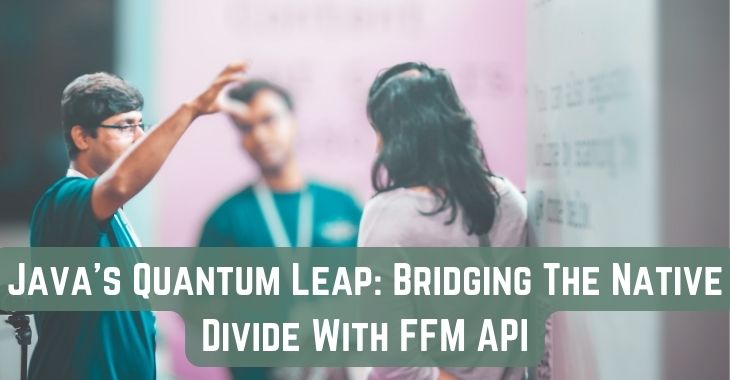
“Once again Saltmarch has knocked it out of the park with interesting speakers, engaging content and challenging ideas. No jetlag fog at all, which counts for how interesting the whole thing was."
Cybersecurity Lead, PwC

This article delves into the intricacies of Java's Foreign Function & Memory API (FFM API), introduced in JEP 442, exploring its history, motivations, goals, and functionalities. The discussion spans from memory segments and arenas to upcalls and safety considerations, highlighting the seismic shift JEP 442 brings in managing native code interactions. Gain insights into the architecture and advantages of the FFM API, thus understanding its potential to promote safer, more efficient coding practices. Appreciate how JEP 442 is poised to revolutionize the Java platform, making it increasingly user-friendly, performant, and secure.
Albert Einstein, one of the great minds of the 20th century, famously said, "Make everything as simple as possible, but not simpler." As we delve into the world of Java's Foreign Function & Memory (FFM) API, these words resonate louder than ever. Our journey into the Java universe today aims to shed light on the potential revolution this innovation might trigger in Java-native interactions.
Developers dealing with the Java-Native Interface (JNI) often found themselves on a razor's edge - one wrong step, and the application would crash. Add the complexities of ByteBuffer and Unsafe classes, and you're playing with fire. Enter the FFM API, Java's latest tool to bridge the chasm between Java code and native code. A carefully crafted blend of simplicity and sophistication, the FFM API seeks to transform the developer's native interaction experience.
In the past, memory management and function calls in Java-native interactions had been a complex dance, with JNI, ByteBuffer, and Unsafe classes taking the center stage. The need for a safer, more efficient mechanism was increasingly apparent, prompting the inception of Project Panama in 2017, which eventually gave birth to the FFM API.
Let's get to the heart of it. The FFM API introduces Memory Segments, which act as safety curtains between your code and the native memory, protecting your application from fatal crashes. Think of them as protective bubbles that encapsulate native memory, allowing you to interact with it without leaving the comfort of the Java realm. Even better, these segments are thread-confined and auto-closable, making concurrency issues and memory leaks less of a nightmare.
The real magic, however, lies in how FFM API enables structured access to native memory. The API introduces Memory Layouts, acting as blueprints for memory segments. By mapping memory segments to these layouts, we can easily navigate the intricate native memory structure.
Consider a scenario where you'd traditionally use a ByteBuffer. With the FFM API, you could instead create a Memory Segment, offering you more control and safety. For instance, allocating off-heap memory using the FFM API can be as simple as:
The beauty lies in the try-with-resources statement, which ensures the Memory Segment is closed, and the native memory is deallocated when done.
One of the advanced features of FFM API is Memory Arenas - more sophisticated Memory Segments. They allow the batch allocation and deallocation of native memory segments, offering significant performance improvements.
The FFM API goes beyond just memory management - it also simplifies interactions with foreign functions. Traditionally, linking Java code to native functions through JNI was like walking on eggshells - a mismatch in function signatures, and your application could crash without any exceptions. The FFM API, however, offers a safer alternative by encapsulating native functions in method handles. These method handles, unlike JNI, allow for type checking and conversions, safeguarding your application from fatal crashes.
Despite its many promises, the FFM API does not claim to be an elixir for all JNI ailments. Certain parts of the API, such as the linker and some memory segments, are still inherently unsafe. However, what sets it apart is its explicit communication about these risks. By default, the use of such unsafe methods issues a warning, guiding developers to tread cautiously. Over time, developers may increasingly prefer the more predictable FFM API over the more dangerous JNI.
The FFM API is not just an ambitious step towards a safer Java-native interaction; it's also a launchpad for future enhancements. A tool named jextract is already in the works, promising to generate native method handles from native library headers, further simplifying native interactions.
So, as we set sail into the future, it's safe to say that Java's FFM API stands true to Einstein's wisdom, making native interactions as simple as possible, but not simpler. It may not be the perfect solution, but it's a giant leap in the right direction. In the spirit of Java's ethos of "Write Once, Run Anywhere," the FFM API is a testament to the quest for simplicity amidst complexity, safety amidst uncertainty, and the relentless pursuit of innovation.
Have questions or comments about this article? Reach out to us here.
Banner Image Credits: Attendees at Great International Developer Summit

“Once again Saltmarch has knocked it out of the park with interesting speakers, engaging content and challenging ideas. No jetlag fog at all, which counts for how interesting the whole thing was."
Cybersecurity Lead, PwC

“Very much looking forward to next year. I will be keeping my eye out for the date so I can make sure I lock it in my calendar."
Software Engineering Specialist, Intuit

“Best conference I have ever been to with lots of insights and information on next generation technologies and those that are the need of the hour."
Software Architect, GroupOn

“Happy to meet everyone who came from near and far. Glad to know you've discovered some great lessons here, and glad you joined us for all the discoveries great and small."
Web Architect & Principal Engineer, Scott Davis

“Wonderful set of conferences, well organized, fantastic speakers, and an amazingly interactive set of audience. Thanks for having me at the events!"
Founder of Agile Developer Inc., Dr. Venkat Subramaniam

“What a buzz! The events have been instrumental in bringing the whole software community together. There has been something for everyone from developers to architects to business to vendors. Thanks everyone!"
Voltaire Yap, Global Events Manager, Oracle Corp.